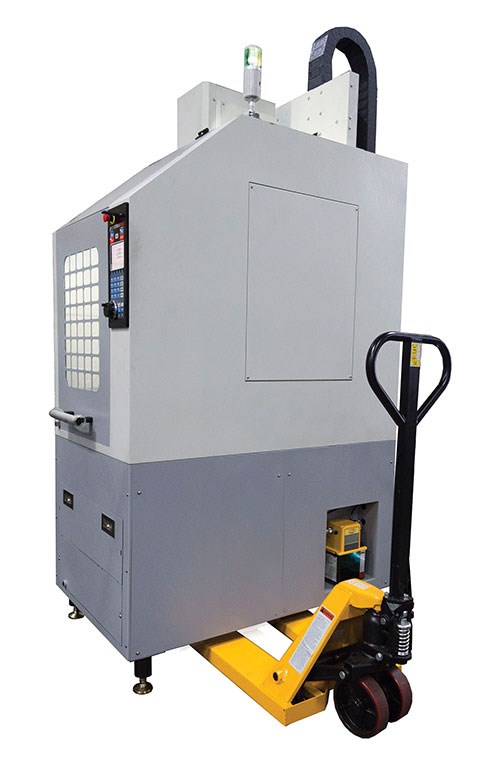The Value of a Portable Second-Op Machine
A portable second-op machine can make more effective use of labor while freeing primary machines to carry out the complicated work they were designed to perform.
Share





Today’s CNC machine tools are more sophisticated than ever. Their faster production speeds and improved capabilities offer shops the potential to improve efficiency, competitiveness and profitability. Plus, a basic dollar-to-dollar comparison shows they are less expensive than machining technology of the past. On the other hand, labor costs continue to increase, while the pool of talented shopfloor personnel remains shallow. This has spurred shops to identify ways to decrease the labor time (i.e., labor cost) needed to produce parts on their advanced, relatively inexpensive machines.
So how is this done? Shops that produce parts in large volumes often organize machines into cells. This enables one person to tend multiple machines, thereby spreading the cost of that employee over the output of several pieces of equipment. However, cells are typically impractical for small- to mid-sized shops that run a variety of jobs in small batches. Those businesses are often forced to divide each job into several independent operations that might require multiple machines and multiple setups. In some cases, an operator might simply stand idle waiting for a machine to complete each cycle, which increases per-piece labor costs. Shops facing these situations can likely benefit from a portable second-op machine, such as Southwestern Industries’ new Trak 2OP.
The easily transportable Trak 2OP vertical machining center is said to be the first CNC machine tool designed specifically for second-op work. It enables a shop to deploy an additional spindle where needed so an operator can tend multiple machines simultaneously. Shops can also shift less-challenging, secondary-op work from its primary machine to the Trak 2OP, freeing the primary machine to perform the complex operations for which it was designed. Similarly, the Trak 2OP is well-suited for shops that perform primary batch-processing work on a turning center followed by secondary batch-processing work on a manual mill. Using the portable CNC unit eliminates manual processes, which are labor-intensive and introduce the risk of operator error. Plus, an operator who would otherwise wait for the turning center to complete its cycle can tend the secondary-op machine instead.
Because the Trak 2OP has a footprint of 2.5 by 4 feet, it can be located in a small area that is convenient for the operator to access. When necessary, the machine can be moved to new shopfloor locations using a pallet jack. In fact, a pallet jack comes standard with each Trak 2OP. The machine’s standard eight-station toolchanger eliminates the need for manual tool changes, while an integral Jergens Ball Lock system facilitates quick change-overs.
As with all Southwestern Industries machines, the Trak 2OP uses the Prototrak conversational CNC. Programs can be generated either at the machine or remotely for common second-op tasks, such as drilling, tapping, countersinking, face milling, and the creation of profiles, pockets and bolt hole patterns.
Related Content
-
6 Machine Shop Essentials to Stay Competitive
If you want to streamline production and be competitive in the industry, you will need far more than a standard three-axis CNC mill or two-axis CNC lathe and a few measuring tools.
-
Orthopedic Event Discusses Manufacturing Strategies
At the seminar, representatives from multiple companies discussed strategies for making orthopedic devices accurately and efficiently.
-
High RPM Spindles: 5 Advantages for 5-axis CNC Machines
Explore five crucial ways equipping 5-axis CNC machines with Air Turbine Spindles® can achieve the speeds necessary to overcome manufacturing challenges.























.jpg;maxWidth=300;quality=90)


